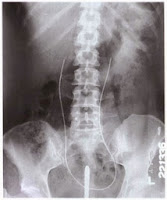Retrograde Urography Procedure
Retrograde Urography is usually taken in AP Projection and positioned the patient in modified litothomy position, Retrograde urography is an examination of kidneys, ureters and bladder with the use and administration of contrast media. The contrast media or agent is injected into pelvicalyceal system via ureters with the use of catheter. When contrast agent are injected the image improves and opacifies the renal collecting system but little physiologic information gathered on the urinary system.Indications and Contraindications of Retrograde Urography:
 |
| Modified Litothomy Position |
Examination Procedure:
Retrograde urography is done in specialized aseptic room like operating system, it is a combined urologic-radiologic examination and carefully done under aseptic condition by the urologist, and assistance of a nurse and radiographer is needed.The procedure is performed in a specially equipped cystoscopic-radiographic examining room, because of its collaborative nature, it may be located in the urology department or the radiology department.
The nurse is responsible for the preparation of the instruments, care and draping of the patient. One of the radiographer responsibilities is to ensure that the overhead parts of the radiographic equipment are free of dust for the protection of the operative field and the sterile layout.
Retrogade Urography: AP Projection
 |
| Urogram Radiograph |
If a general anesthetic is not used, the radiographer explains the breathing procedure to the patient and checks the patient's position table. The kidneys and the full extend of the ureters in patients of average height are included on a 35 x 43 cm IR when the third lumbar vertebra is centered to the grid.
To make the lumbar less curve radiographer needs to elevate the thigh, and if does not reduce the curve radiographer may put pillow under patient's head and shoulder so that the back is in contact with the table. Most tables used in cystoscopic-radiography are equipped with an adjustable leg rest to permit extension of the patient's legs for certain radiographic studies.
The urologist then performs catherization of the ureters through a ureterocystoscope, which is a cystoscope with an arrangement that aids insertion of the catheters into the vesicoureteral orifices. After the endoscopic examination, the urologist passes a ureteral catheter well into on or both ureters and leaving the catheters in position, usually withdraws the cystoscope.







